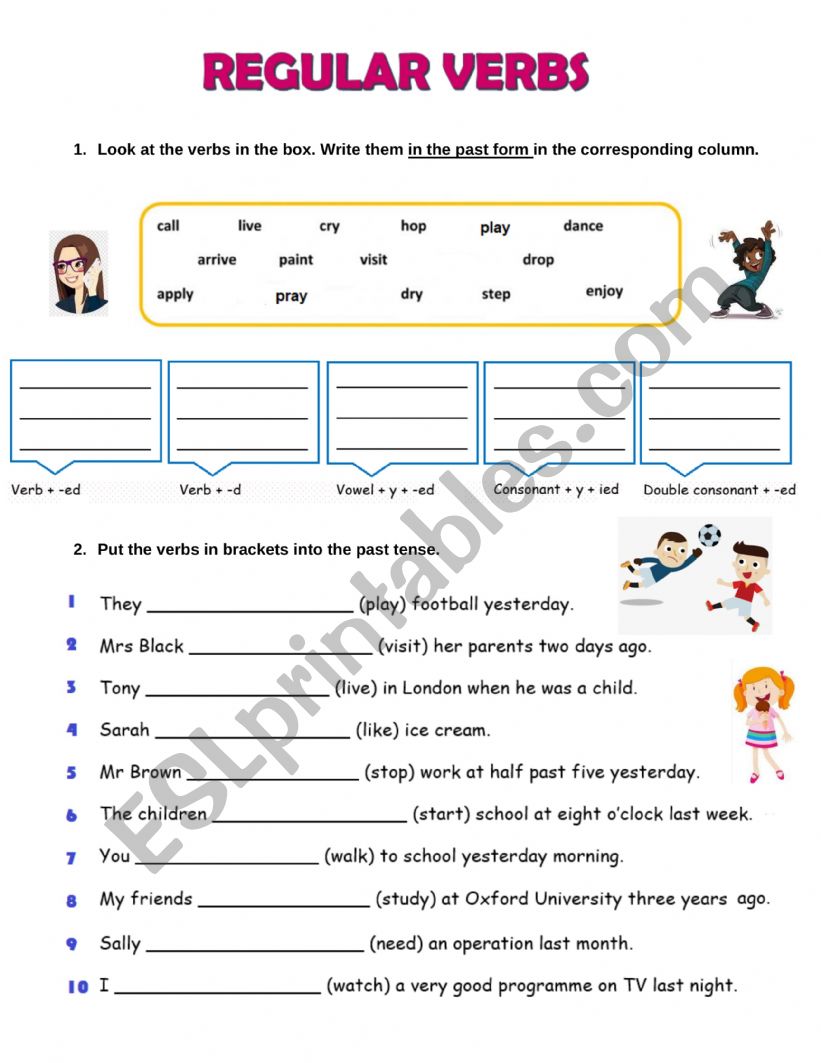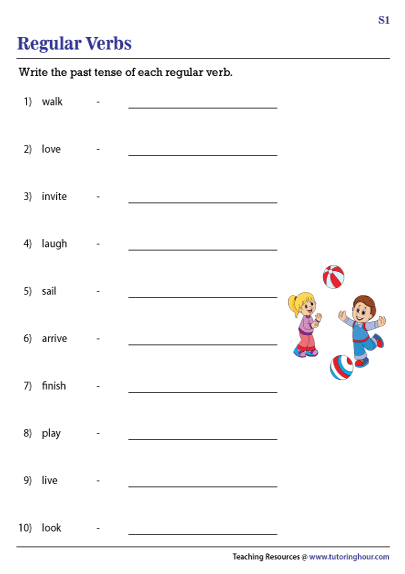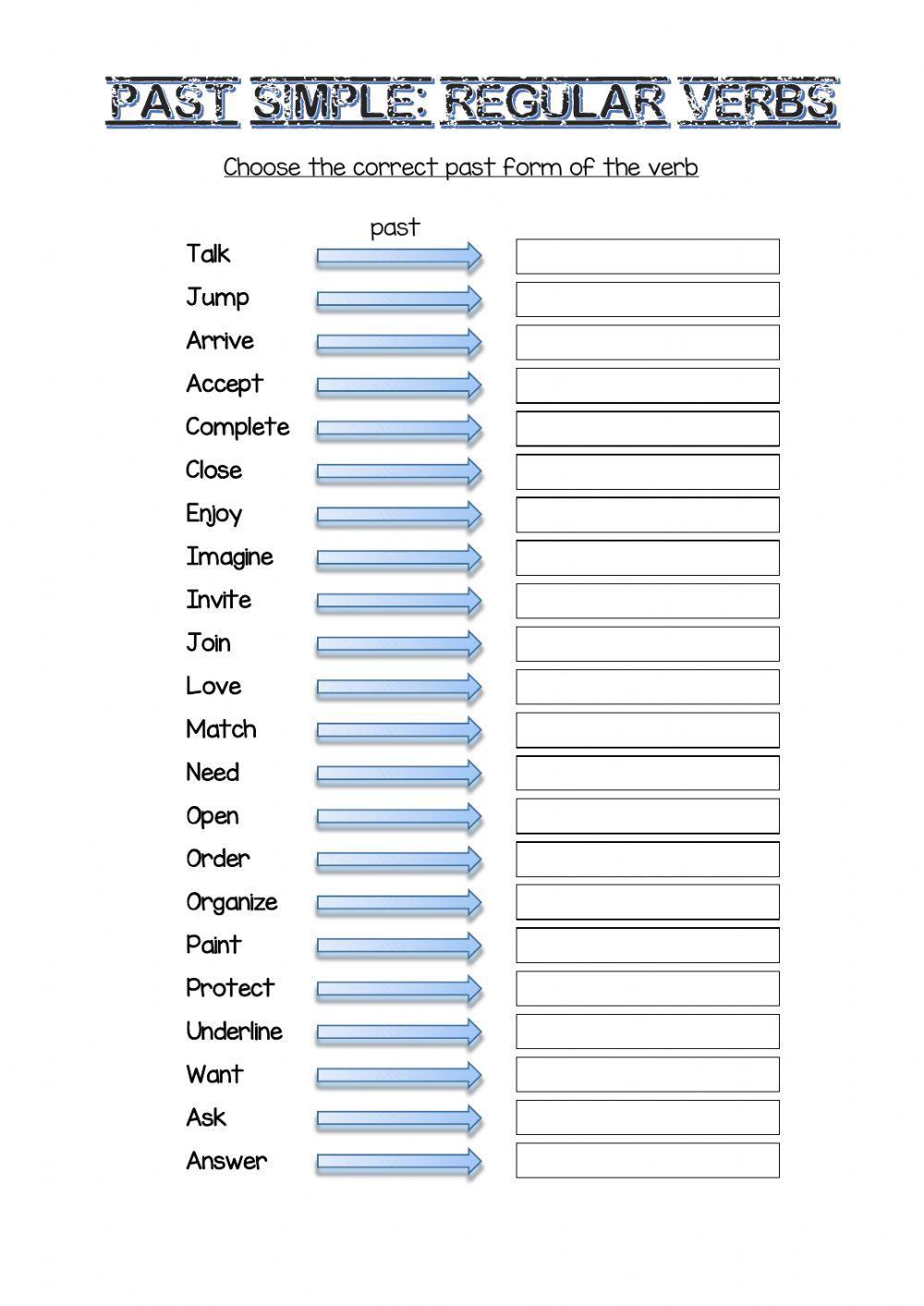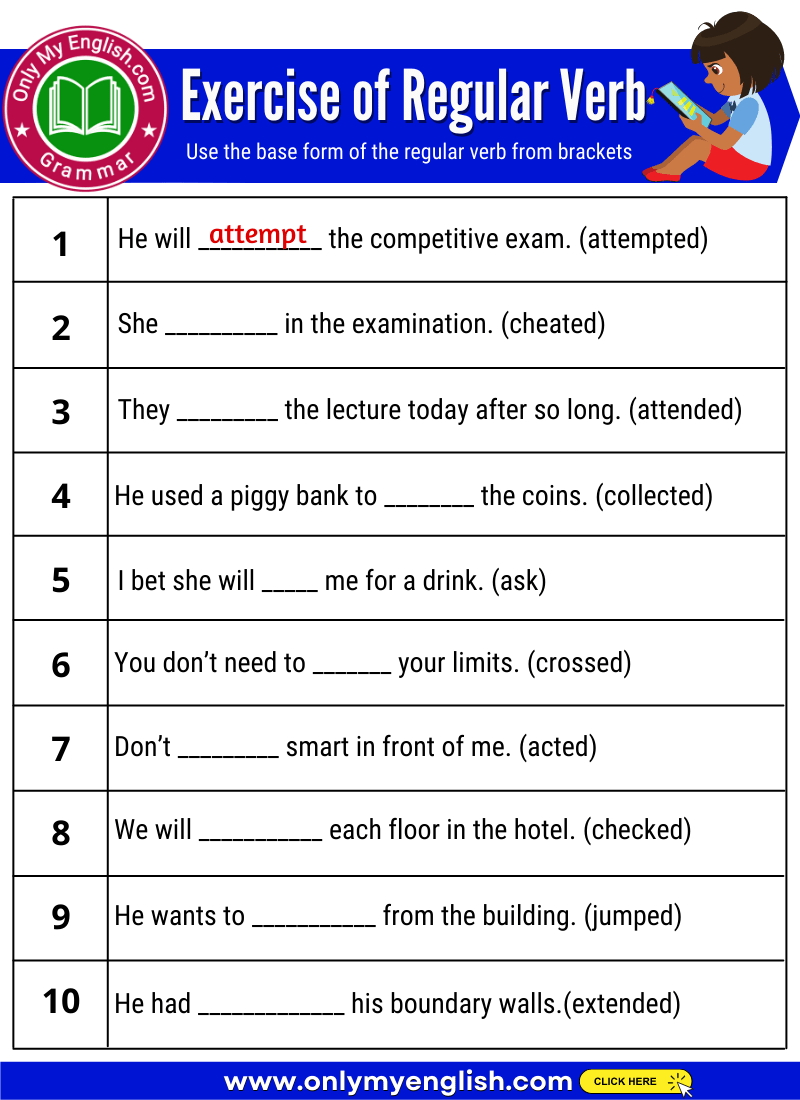
Mastering the Building Blocks: The Indispensable Role of Regular Verbs Worksheets
In the vast and intricate landscape of the English language, verbs stand as the dynamic engines of sentences, conveying action, state, or occurrence. Among them, regular verbs form the foundational bedrock, providing a predictable and systematic pathway to understanding tense and conjugation. For language learners, educators, and even seasoned speakers looking to refine their skills, the journey to verb mastery often begins with consistent, targeted practice. This is precisely where Regular verbs worksheets emerge as an invaluable and indispensable tool.
This comprehensive article will delve into the profound significance of regular verbs, explore the multifaceted benefits of utilizing worksheets for their acquisition, discuss various types of exercises, offer guidance on creating and effectively using these resources, and ultimately underscore why a dedicated approach to regular verb practice, especially through well-designed Regular verbs worksheets, is paramount for achieving fluency and accuracy in English.
The Predictable Power of Regular Verbs

Before diving into the utility of worksheets, it’s crucial to understand what regular verbs are and why they are so fundamental. In English, verbs change their form to indicate tense (when an action happened), mood (the speaker’s attitude), and voice (who performs or receives the action). Regular verbs are those that form their past simple tense and past participle by simply adding "-ed" to the base form. For example:

- Base form: walk → Past Simple: walked → Past Participle: walked
- Base form: play → Past Simple: played → Past Participle: played
- Base form: love → Past Simple: loved → Past Participle: loved



While there are some minor spelling rules (e.g., doubling the final consonant like "stop" to "stopped," or changing "-y" to "-ied" like "study" to "studied"), the core principle of adding "-ed" remains consistent. This predictability makes regular verbs an ideal starting point for learners, providing a sense of accomplishment and building a strong grammatical foundation before tackling the often-unpredictable world of irregular verbs.
Why Regular Verbs Worksheets Are Essential for Learning
The utility of Regular verbs worksheets extends far beyond mere rote memorization; they serve as dynamic instruments for reinforcing rules, promoting active recall, and solidifying understanding. Here’s a breakdown of their multifaceted benefits:

- Systematic Reinforcement: Worksheets provide structured, repetitive practice that is crucial for internalizing grammatical rules. By repeatedly applying the "-ed" rule in various contexts, learners build muscle memory for correct conjugation.
- Active Recall and Application: Unlike passive learning (e.g., just reading a list of verbs), worksheets demand active engagement. Learners must recall the correct form and apply it, which strengthens neural pathways and improves retention.
- Identification of Gaps: When a learner struggles with a particular type of exercise on a worksheet (e.g., verbs ending in -y, or those requiring consonant doubling), it immediately highlights areas where further instruction or practice is needed. This diagnostic capability is invaluable for both learners and educators.
- Independent Learning and Self-Paced Practice: Worksheets empower learners to practice at their own pace, outside of a classroom setting. This is particularly beneficial for self-study, homework, or for students who need extra time to grasp concepts.
- Assessment and Progress Tracking: For teachers, worksheets offer a quick and effective way to assess student comprehension and track progress over time. For learners, seeing their improved scores on successive worksheets can be highly motivating.
- Confidence Building: Successfully completing exercises on a worksheet provides a sense of achievement, boosting a learner’s confidence in their ability to use English correctly. This positive reinforcement is vital for sustained motivation.
- Structured Learning Environment: Worksheets break down complex grammatical concepts into manageable, digestible chunks. This structured approach prevents overwhelm and allows learners to focus on one specific aspect of verb usage at a time.
- Preparation for Productive Skills: A solid understanding of regular verb conjugation, honed through worksheet practice, directly translates to improved speaking and writing skills. When the basic mechanics are automatic, learners can focus more on conveying meaning and less on grammatical accuracy.



Exploring the Diverse Types of Regular Verbs Worksheets
Effective Regular verbs worksheets come in various formats, each designed to target different aspects of learning and cater to diverse learning styles. A comprehensive approach often involves a mix of these types:
-
Basic Conjugation Drills:
- Fill-in-the-blanks: Learners are given a sentence with a blank and the base form of a regular verb in parentheses, e.g., "Yesterday, I __ (walk) to the park."
- Matching: Match base forms with their past simple/past participle forms.
- Tables: Complete a table with base form, past simple, and past participle for a list of verbs.
-
Sentence Completion and Contextual Usage:
- Story Completion: Provide a short story with blanks where learners must insert the correct past simple form of regular verbs to make sense of the narrative.
- Dialogue Completion: Fill in verbs in a conversation snippet.
- Descriptive Writing Prompts: Learners write short paragraphs describing past events using provided regular verbs.
-
Transformation Exercises:
- Present to Past: Rewrite sentences from the present simple to the past simple.
- Affirmative to Negative/Interrogative: Transform affirmative sentences into their negative or question forms using "did/didn’t." E.g., "She cooked dinner" → "She didn’t cook dinner." / "Did she cook dinner?"
-
Error Correction:
- Learners are given sentences containing errors in regular verb conjugation (e.g., "He walk to school yesterday") and must identify and correct them. This builds critical thinking and attention to detail.
-
Picture-Based Worksheets:
- Students describe actions depicted in pictures using regular verbs in the past tense. This is especially useful for visual learners and younger students.
-
Spelling Rule Focus:
- Specific exercises that target verbs ending in -y, verbs ending in -e, or verbs requiring consonant doubling (e.g., "plan" → "planned").
-
Multiple Choice:
- Choose the correct past simple form from a list of options. While less active than fill-in-the-blanks, it’s good for quick checks and reinforcement.
How to Create Effective Regular Verbs Worksheets
For educators and parents looking to design their own Regular verbs worksheets, certain principles ensure their effectiveness:
- Clear and Concise Instructions: Make sure learners understand exactly what they need to do for each exercise. Use simple language.
- Varied Exercise Types: Don’t stick to just one format. Mix and match to keep learners engaged and target different skills.
- Appropriate Difficulty Level: Tailor the vocabulary and sentence complexity to the learners’ proficiency level. Start simple and gradually increase the challenge.
- Engaging Content: Whenever possible, use themes, topics, or scenarios that are interesting and relevant to the learners. Story-based exercises are often more captivating.
- Visual Appeal: Use clear fonts, adequate spacing, and consider incorporating relevant images or simple graphics, especially for younger learners.
- Provide Answer Keys: This is crucial for independent learning and self-correction. Learners can check their work and understand where they made mistakes.
- Ample Space for Answers: Ensure there’s enough room for learners to write their responses clearly.
Maximizing the Impact of Regular Verbs Worksheets
Simply handing out worksheets isn’t enough; how they are used significantly impacts their effectiveness:
- Pre-teaching and Review: Before assigning a worksheet, ensure that the rules for regular verb conjugation have been clearly explained and demonstrated. Review these rules briefly before students begin.
- Contextualize: Encourage learners to understand the meaning of the verbs they are conjugating, not just the mechanical rule. Discuss when and why these tenses are used.
- Timed vs. Untimed Practice: For initial practice, untimed exercises reduce pressure. Once learners are more confident, timed drills can help improve fluency and speed of recall.
- Self-Correction and Peer Correction: Encourage learners to use the answer key to check their own work, identifying their mistakes. Peer correction can also be a valuable learning experience.
- Provide Constructive Feedback: For educators, don’t just mark answers right or wrong. Explain why an answer is incorrect and offer guidance for improvement.
- Integrate with Productive Skills: After completing a worksheet, encourage learners to use the same verbs in speaking or writing activities. For instance, after filling in sentences, ask them to tell a story using those sentences.
Integrating Worksheets with Broader Language Learning
While worksheets are excellent for targeted practice, they should not exist in a vacuum. To truly master regular verbs, their use must be integrated with other communicative activities:
- Speaking: Encourage students to describe their past day, weekend, or a recent event using regular verbs. Role-plays where characters recount past actions are also effective.
- Writing: Assign short journal entries, narratives, or summaries that require the consistent use of regular verbs in the past tense.
- Listening: Play audio clips or short stories and have students identify and write down the regular verbs they hear. Dictation exercises are also useful.
- Games: Incorporate games like "verb charades" (acting out regular verbs) or "verb bingo" (marking off verbs as they are called out).
Common Pitfalls and How Worksheets Help
Learners often encounter specific challenges when learning regular verbs:
- Over-generalization: Applying the "-ed" rule to irregular verbs (e.g., "goed" instead of "went"). Worksheets help by clearly separating regular and irregular verb practice.
- Spelling Rules: Forgetting to double consonants ("plan" vs. "planed") or change "y" to "ied" ("study" vs. "studyd"). Worksheets specifically designed to target these spelling rules can provide the necessary focused practice.
- Incorrect Use of "Did/Didn’t": Confusing "I didn’t walked" with "I didn’t walk." Transformation exercises on worksheets directly address this by requiring learners to switch between affirmative, negative, and interrogative forms.
By isolating these common areas of difficulty, well-crafted Regular verbs worksheets provide the precise remedial practice needed to overcome them.
Conclusion
The journey to English proficiency is built upon a series of foundational elements, and the correct use of regular verbs stands as one of the most crucial. While diverse learning methods exist, the consistent and strategic use of Regular verbs worksheets offers an unparalleled pathway to systematic reinforcement, active recall, and confident application. From basic conjugation drills to contextual storytelling, these versatile tools empower learners to internalize the predictable patterns of regular verbs, identify and correct their mistakes, and ultimately build the strong grammatical backbone necessary for fluent and accurate communication.
Whether you are an educator striving to provide effective learning materials or a dedicated student committed to mastering the nuances of English, embracing the power of Regular verbs worksheets is a decision that will undoubtedly yield significant and lasting linguistic dividends. They are not merely papers to be filled; they are stepping stones to grammatical mastery, paving the way for richer, more precise, and more confident expression in the English language.
